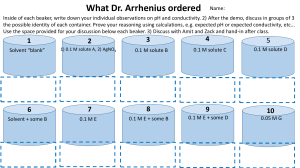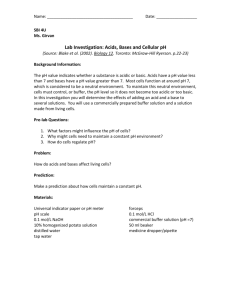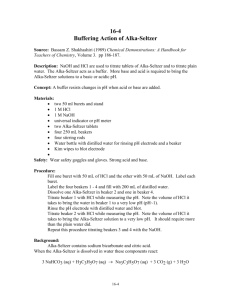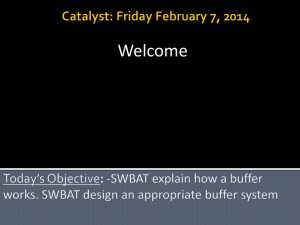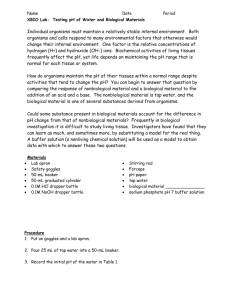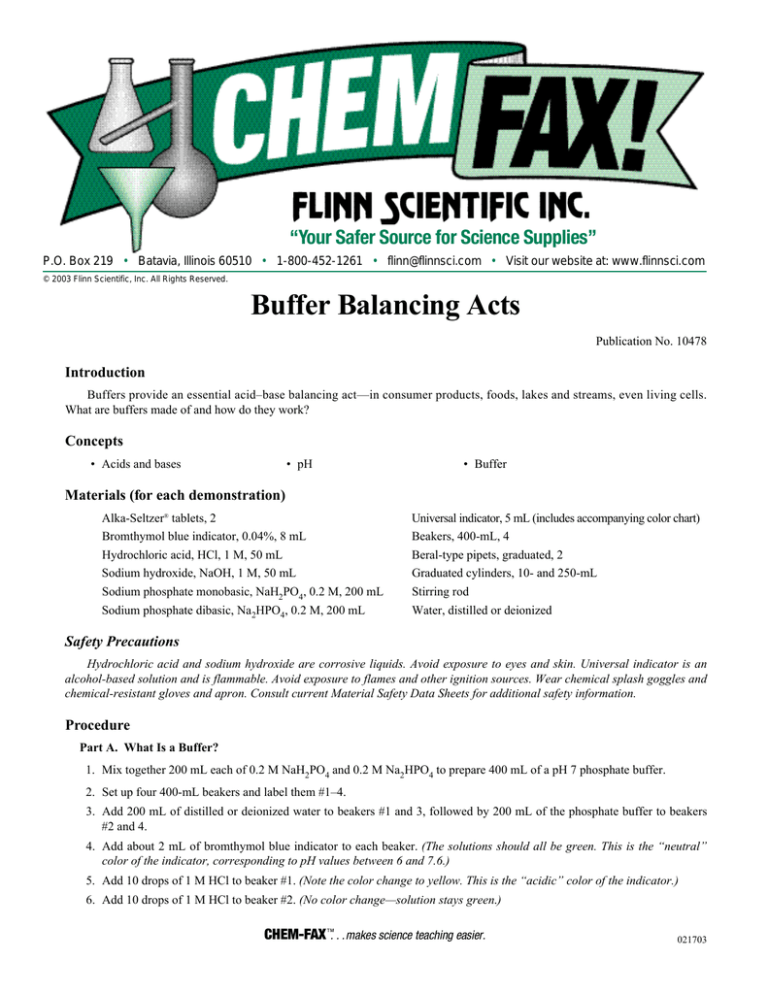
“Your Safer Source for Science Supplies”
P.O. Box 219 • Batavia, Illinois 60510 • 1-800-452-1261 • flinn@flinnsci.com • Visit our website at: www.flinnsci.com
© 2003 Flinn Scientific, Inc. All Rights Reserved.
Buffer Balancing Acts
Publication No. 10478
Introduction
Buffers provide an essential acid–base balancing act—in consumer products, foods, lakes and streams, even living cells.
What are buffers made of and how do they work?
Concepts
• Acids and bases
• pH
• Buffer
Materials (for each demonstration)
Alka-Seltzer® tablets, 2
Bromthymol blue indicator, 0.04%, 8 mL
Hydrochloric acid, HCl, 1 M, 50 mL
Sodium hydroxide, NaOH, 1 M, 50 mL
Sodium phosphate monobasic, NaH2PO4, 0.2 M, 200 mL
Sodium phosphate dibasic, Na2HPO4, 0.2 M, 200 mL
Universal indicator, 5 mL (includes accompanying color chart)
Beakers, 400-mL, 4
Beral-type pipets, graduated, 2
Graduated cylinders, 10- and 250-mL
Stirring rod
Water, distilled or deionized
Safety Precautions
Hydrochloric acid and sodium hydroxide are corrosive liquids. Avoid exposure to eyes and skin. Universal indicator is an
alcohol-based solution and is flammable. Avoid exposure to flames and other ignition sources. Wear chemical splash goggles and
chemical-resistant gloves and apron. Consult current Material Safety Data Sheets for additional safety information.
Procedure
Part A. What Is a Buffer?
1. Mix together 200 mL each of 0.2 M NaH2PO4 and 0.2 M Na2HPO4 to prepare 400 mL of a pH 7 phosphate buffer.
2. Set up four 400-mL beakers and label them #1–4.
3. Add 200 mL of distilled or deionized water to beakers #1 and 3, followed by 200 mL of the phosphate buffer to beakers
#2 and 4.
4. Add about 2 mL of bromthymol blue indicator to each beaker. (The solutions should all be green. This is the “neutral”
color of the indicator, corresponding to pH values between 6 and 7.6.)
5. Add 10 drops of 1 M HCl to beaker #1. (Note the color change to yellow. This is the “acidic” color of the indicator.)
6. Add 10 drops of 1 M HCl to beaker #2. (No color change—solution stays green.)
CHEM-FAXE. . .makes science teaching easier.
021703
7. Add an extra 10 drops of 1 M HCl to beaker #2. (Still no color change. Look frustrated!)
8. Use a graduated cylinder to add 5 mL of 1 M HCl to beaker #2. (The frustration mounts as the solution remains green.)
9. Continue adding 1 M HCl in 5-mL increments until the color changes to yellow. (This will probably take 2–3 more 5-mL
portions of HCl, for a total of 15–20 mL.)
10. Discuss the behavior of the buffer with respect to excess strong acid. What will happen if strong base is added?
11. Add 10 drops of 1 M NaOH to beaker #3. (Note the color change to blue. This is the “basic” color of the indicator.)
12. Repeat steps 6–9 with 1 M NaOH and the buffer solution in beaker #4. (A total of 15–20 mL of NaOH will be needed to
change the buffer to blue.)
13. Discuss the composition and properties of a buffer. (A buffer is a solution prepared from a weak acid and its conjugate
base that resists pH changes upon addition of strong acid or base.)
Part B. Buffer Action in a Consumer Product
1. Set up four clean beakers and relabel them #1–4, if necessary.
2. Add 200 mL of distilled or deionized water to each beaker. Dissolve one Alka-Seltzer tablet in each beaker #2 and 4.
3. Read the label on the Alka-Seltzer tablet and note the principal ingredients listed. Are there any weak acids and weak
bases present that are capable of forming a buffer? (The active buffer ingredients are citric acid and sodium bicarbonate.)
4. Add about 20 drops (1 mL) of universal indicator solution to each beaker #1–4. Note the color of each solution and use the
color chart to estimate the initial pH of each solution. (The solutions should all be yellow-green, pH 6–7)
5. Add 1 mL of 1 M HCl to beakers #1 and 2. Compare the indicator color and pH of each solution. (Water will turn red,
indicating a pH ≤ 4. The Alka-Seltzer solution should stay green, pH 6–7, suggesting that it is acting as a buffer.)
6. Continue adding 1 M HCl in 1-mL increments to the Alka-Seltzer solution in beaker #2 until the indicator color is the
same as that in beaker #1. How much acid must be added to overwhelm the buffer capacity of one Alka-Seltzer tablet?
(This will probably take about 20 mL of 1 M HCl.)
7. Add 1 mL of 1 M NaOH to beakers #3 and 4. Compare the indicator color and pH of each solution. (Water will turn purple, indicating a pH ≥ 10. The Alka-Seltzer solution should stay green, pH 6-7, suggesting that it acts as a buffer against
both acid and base.)
8. Continue adding 1 M NaOH in 1-mL increments to the Alka-Seltzer solution in beaker #4 until the indicator color is the
same as that in beaker #3. How much base must be added to overwhelm the buffer capacity of one Alka-Seltzer tablet?
(This will take about 20 mL of 1 M NaOH. The buffer capacity of Alka-Seltzer is similar against both acids and bases.)
Disposal
All final solutions may be disposed of down the drain with plenty of excess water according to Flinn Scientific Disposal
Method #26b. Please consult your current Flinn Scientific Catalog/Reference Manual for general guidelines and specific procedures governing the disposal of laboratory waste.
Tip
• For best results, use either freshly distilled water, boiled distilled water, or bottled water as the control in Parts A and B.
Distilled water may absorb large quantities of carbon dioxide from the air during storage. The presence of dissolved CO2
may make the water acidic enough to turn yellow with bromthymol blue. In areas of the country where the water is not
hard, tap water may be a suitable control.
Reference
Flinn ChemTopic™ Labs, Vol. 13 Acids and Bases; Flinn Scientific: Batavia, IL, 2002.
Buffer Balancing Acts is available as a chemical demonstration kit from Flinn Scientific, Inc.
Catalog No.
AP6288
Description
Buffer Balancing Acts—
Chemical Demonstration Kit
–2–
© 2003 Flinn Scientific, Inc. All Rights Reserved.
Price/Each
Consult Your
Current Flinn
Catalog/Reference
Manual.

